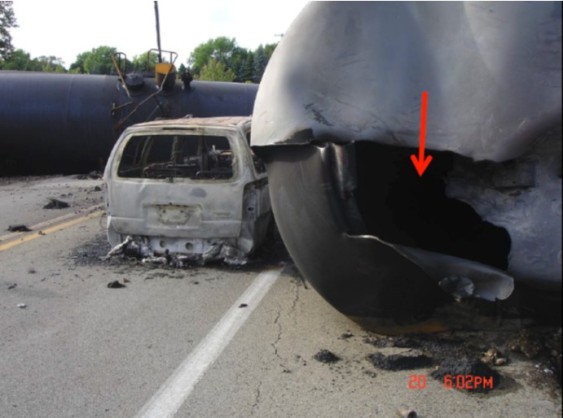[prettyquote]“Clearly, the heads and shells of DOT-111 tank cars…can almost always be expected to breach in derailments that involve pileups or multiple car-to-car impacts.” — National Transportation Safety Board, June 19, 2009.[/prettyquote]
Much of the oil traveling by train to the profusion of new oil-by-rail terminals is shipped in what one Chicago-area leader called the “Ford Pinto of railroad cars.” These are the soda-can shaped tank cars, DOT-111s, built to standards in effect as recently as 2011 that have a “high incidence of failure during accidents.” If used to ship crude oil, their design flaws pretty much guarantee that a serious train derailment will lead to oil spills or massive explosions.
One summer night in 2013, a rail accident involving DOT-111s resulted in a catastrophic explosion that killed 47 people in a small town in Quebec. In the months that followed, DOT-111s carrying oil unleashed towering explosions in Alabama, North Dakota, and New Brunswick.
These mishaps were not accidents, so much as they were the logical consequence of a sea change in the way that we transport crude oil. A few years ago, a sudden oil boom from shale geologies, such as the Bakken formation of western North Dakota, caught almost everyone by surprise. With few good options for moving the abundant new found oil to market, companies turned to railroads in a big way: shipments of crude oil by rail spiked, and then spiked again.
Yet shippers are moving oil largely in the old DOT-111 tank cars that for more than 20 years we’ve known are unsafe. In fact, since 1991, the National Transportation Safety Board (NTSB) has issued several crash investigation and safety recommendation reports involving tank cars documenting the inadequacies of the DOT-111 standard.
Things came to a head after a high profile collision in 2009 when a slow moving train composed of DOT-111 cars hauling ethanol derailed at a road-crossing in Cherry Valley, Illinois. The resulting fireball fatally burned a passenger and seriously injured three others in vehicles waiting at the crossing. Local officials had to evacuate residents within a half-mile of the incident.







